In the United States, agriculture has always been important. The term agriculture comes from the Greek word agros meaning "the soil" or "a field." Agriculture begins with the land, and in Iowa the land is very fertile.
The land itself, like the people who live on it, has a history. Iowa's fertile soil developed over thousands and thousands of years. As the prairie grasses grew and died, their roots decayed making rich black dirt.
It was on this fertile land that Indian groups planted and harvested their crops. It was also this fertile soil that attracted pioneer settlers to the region we now call Iowa.
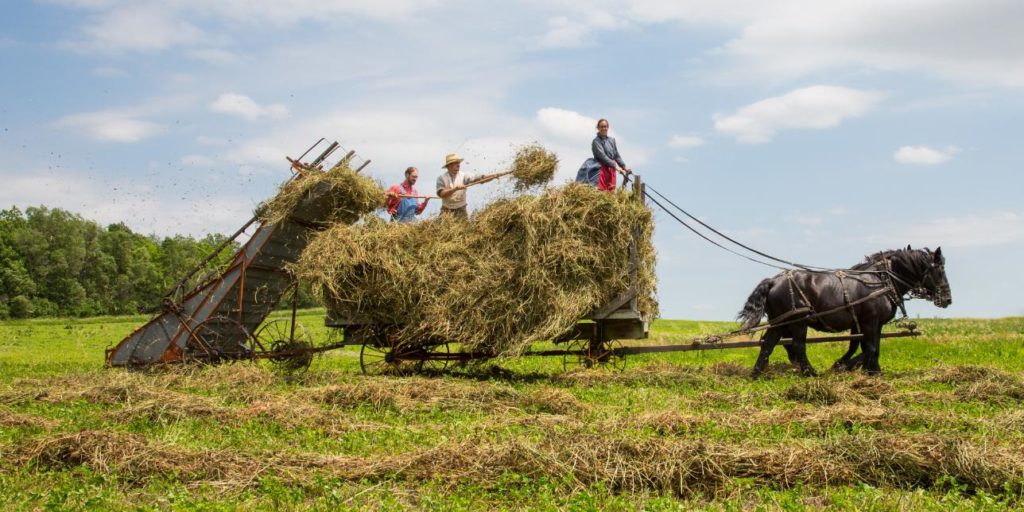
Many scientists believe the first people to live in North America arrived over twenty thousand years ago. During the last twelve thousand years, people have lived in Iowa. These first "Iowans" hunted large animals and moved frequently while following the herds of wooly mammoth and giant buffalo.
The first Iowa farmers may have been the mound builders of northeast Iowa. They planted small gardens and gathered food from the forests. They also built mounds in the shape of animals such as bears, snakes and birds and buried their dead in the mounds along with many objects such as pottery.
Effigy Mounds National Monument, part of the National Park Service, is located in northeast Iowa. There you can see the mounds built by Indian groups many years ago.

National Park Service Photo
About seven hundred years ago, new Indian groups began to move up the Mississippi River valley and into Iowa. They discovered that corn grew well in the rich Iowa soil. Corn originally came from Mexico. As the Indians migrated north, they brought corn with them.
In the late 1600s, French traders and explorers first contacted Indians living in present-day Iowa. The Ioway Tribe was one of these groups.
The Ioway built their homes and villages near Iowa's many streams and rivers and migrated to a new area every few years as they followed the buffalo and elk herds.
Their larger villages may have numbered from 1,000 to 1,500 people, and large fields surrounded these villages. Women tended the gardens of corn, beans, pumpkins, and squash in these fields while men hunted deer and buffalo.
The Indians did not have metal farm tools such as the breaking plow that could slice through the tough prairie sod. For this reason, they lived near the river valleys where the soil was easier to farm.
Early accounts report that they may have planted one-quarter to one-half acre for each member of their tribe.
Later the Sauk and Meskwaki tribes came to live in present-day Iowa during the 1700s.
When pioneer settlement began in eastern Iowa in 1833, the Sauk and Meskwaki were living along the Mississippi River at the mouth of the Rock River.
Like other tribes in the region, the Sauk and Meskwaki women planted many acres of corn each spring in the fields surrounding their villages, and tended gardens of pumpkins, beans and squash. In the summer the men hunted buffalo and elk and bartered for supplies with traders.
The Ioway Indians not only farmed the river valleys, but also hunted in the vast prairie lands. They traded animal skins with Europeans for items such as glass beads, cloth and knives. This trading often took place at the many forts Europeans set up on the frontier.
At first the fur trade was good for both the Indians and the Europeans. Eventually, this trade led to conflicts over land. As time went on, many of the animals that the Indians hunted became scarce, and the tribes needed to find new hunting grounds.
The fur trade moved farther west, and conflicts arose between the Europeans and the Indians.
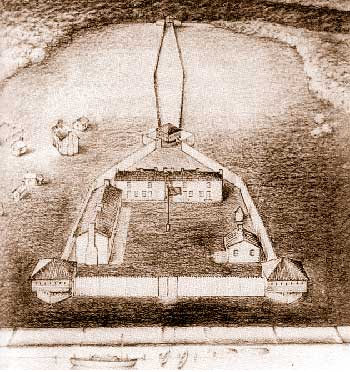
Fort madison on the Mississippi River was built in 1808 to impress
the Indians and help the fur trade.
As these problems increased and pioneer settlers pressed farther west, the U.S. government began moving the Indians even farther west. This caused problems between the various Indian groups as one tribe moved into another's hunting area.
In 1803, the Louisiana Purchase transferred to the United States government all French claims to the region between the Mississippi River and the Rocky Mountains.
With this purchase, the U.S. government claimed the land we now call Iowa as part of the United States. But it wasn't until the 1830's that pioneer farmers from the east began crossing the Mississippi River to settle in Iowa.
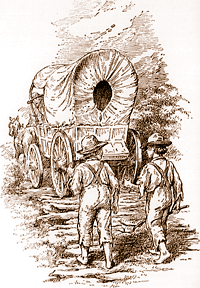 Where Indian groups once freely hunted the buffalo and elk, the pioneer farmer now plowed the rich prairie soil, planted fields and built homes. Pioneer farming was very hard work and nearly all of it was done by hand.
Where Indian groups once freely hunted the buffalo and elk, the pioneer farmer now plowed the rich prairie soil, planted fields and built homes. Pioneer farming was very hard work and nearly all of it was done by hand.
The invention of the steel plow helped to make the hard work of pioneer farming successful. In 1837, John Deere invented a plow with a shiny steel blade. Pulled by oxen or horses, it ripped through the dense sod uncovering the thick black soil.
This was still hard work because the thick prairie grasses had long roots that extended deep into the soil. But the steel plow was superior to the cast iron plows that were made for New England's sandy soil.
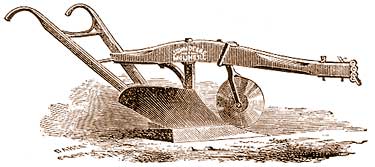
As time went by, farm machinery continued to improve and become more efficient. Early farmers did most of their work by hand or with simple pieces of farm equipment. By 1870, horses had become the most important animal on the farm. They not only pulled wagons and buggies, but also worked in teams to power corn planters, hay rakes and plows.
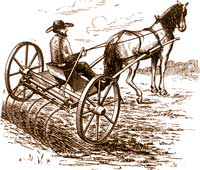 Between 1833 and 1870, over one million pioneer settlers moved into the state. Many of these settlers traveled to Iowa in wagons pulled by horses or oxen. Others came by steamboat and some by stagecoach. Following the Civil War (1861-1865) railroads expanded rapidly replacing the stagecoach.
Between 1833 and 1870, over one million pioneer settlers moved into the state. Many of these settlers traveled to Iowa in wagons pulled by horses or oxen. Others came by steamboat and some by stagecoach. Following the Civil War (1861-1865) railroads expanded rapidly replacing the stagecoach.
Many pioneer settlers who immigrated to Iowa between 1833 and 1870 were born in states to the east of Iowa. They came in large numbers from Ohio, Indiana, Illinois and New York. Other immigrants came from countries such Germany, Great Britain and Ireland.
Today, many Iowa communities still celebrate a special ethnic heritage. For example, Decorah is known for its Norwegian culture, Elkhorn for the Danes and Cedar Rapids for its Czech heritage.
These are just a few of the many Iowa towns that trace their roots to immigrants from afar.
We often think that long ago change happened slowly. But Iowa changed very rapidly between 1833 and 1870. During those 37 years Iowa was transformed from a pioneer frontier to a major agricultural region.
Take a look at the native vegetation in Iowa prior to pioneer settlement. Most of the forests were located along the rivers (area shaded black). The prairie grass covered the rest of the state.
Because of the changes brought on by the Industrial Revolution settlers in 1870 had better horse-drawn equipment. They could farm more land than the early pioneers.
By 1870, all 99 Iowa counties were dotted with towns and farms. Railroads were beginning to transport Iowa farm products throughout the United States. These changes made Iowa the important state it is today.

Copyright © 2022 CampSilos | All Rights Reserved
National Standards | Silos & Smokestacks | Credits | Awards
Crafted by IFC Studios, a midwest Branding Agency.